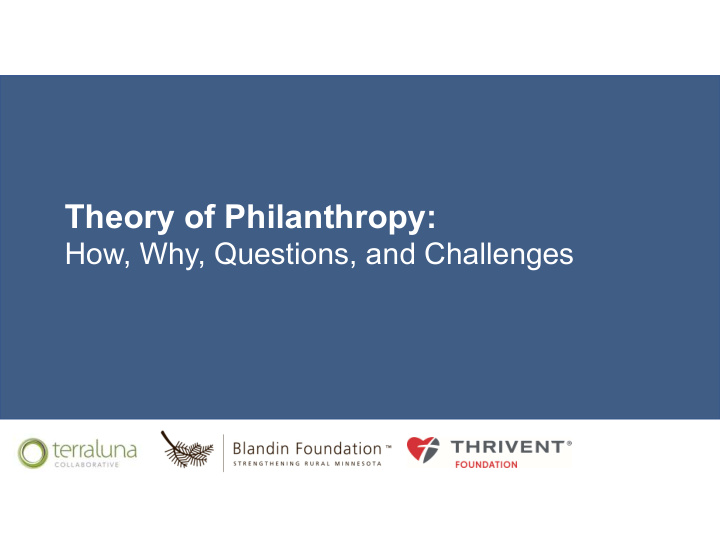



Today’s Guiding Questions Theory of Philanthropy: How, Why, Questions, and Challenges
Today’s Guiding Questions • Why articulate a theory of philanthropy? • What is the articulation process like? • What was the role of the foundation’s stakeholders (team, board, evaluators, etc.)? • What tangible products came from the process? How are they used? Who engages with them? • What new questions did the theory of philanthropy development process prompt the foundation to ask about itself? What questions did the foundation revisit in a new way? Why did those questions matter? • How is the explicit theory of philanthropy incorporated and used in the Foundation? • What pitfalls or traps did the foundation find itself in through the process? • What doesn’t the theory of philanthropy do? What have been its limits?
Introductions Molly Sullivan Noah Gagner Gifty Amarteifio, Ph.D Wade Fauth Michael Dominowski TerraLuna Collaborative TerraLuna Collaborative TerraLuna Collaborative Blandin Foundation Thrivent Foundation Member Member Member Vice President President
TerraLuna Collaborative TerraLuna’s mission is to weave connections and support change at the intersection of learning, arts, and social justice. All of TerraLuna’s work is undertaken with these values serving as guiding principles: • Social justice • Social equity • People-focused • Inclusive and responsive evaluation • One size does not fit all
Blandin Foundation “Our mission is to be a trusted partner and advocate to strengthen rural Minnesota communities, especially the Grand Rapids area. Our vision is healthy, inclusive rural communities.”
Thrivent Foundation “Our mission is to change the odds for people who struggle to advance economically in our communities. We are committed to ensuring that those experiencing the most substantial barriers and disparities can maintain family-sustaining employment and financial health. We believe in the power of inclusive, community-based action to accelerate change in the institutions and systems that ensure all people are economically secure and mobile.”
Theory of Philanthropy v. Theory of Change “A theory of change hypothesizes how change occurs in the world; a theory of philanthropy articulates a foundation’s role in supporting change.” Patton, Foote, Radner, 2015, p. 7
Exercise Introduction Learning Develops deepens understanding understanding Clarity + Coherence Intention Focuses directs action intention + learning
Exercise Introduction • Niche - clean rivers • Collaboration with public and private actors Collaboration • Invest in clean tech (ag. solutions) Niche • Use of leadership (voice, power, and influence) • Risk? Endowment Eval • Consultants facilitate network investing • What to evaluate? • Programs (grant) Consultants Risk • Network? • Investments • Collaborative (pub/priv) network Leadership • Role of leadership • Etc.
Questions?
Developing a Theory of Philanthropy This process is not linear or neat. There is value in following wherever the reflections lead you and embracing the complexity and nuance that surface about your institution’s approach.
Questions?
Takeaways, Learnings, and Future Uses What is the current state of the theory of philanthropy at the Blandin Foundation and Thrivent Foundation? How is it used? Revisited? Modified?
Questions?
Contact Us Wade Fauth wofauth@blandinfoundation.org Mike Dominowski Michael.Dominowski@thrivent.com
Exercise: Individual Reflection • NA – We don’t even talk about this Question 1: Consider how much element of philanthropy clarity and coherence your • 1 – We talk about this element but have organization holds within each little to no clarity or coherence element and why? • 2 – Some clarity and coherence exist but there are some major differences in perception or opinion Question 2: What interconnections • 3 – We are generally clear and share among these elements need more coherence about this element with some clarity and coherence within your small differences or variation organization? • 4 – We are crystal clear, and everyone is on the same page
Exercise: Pair and Share • What did you notice? • Where in your organization do you have more and less clarity and With a partner, discuss your coherence? reflections to the following • What interconnections have more or questions. less clarity? • How might more clarity and coherence within one or more element support your philanthropic purpose? •
Exercise: Reflection What is sticking with you from this activity? What did you learn from this session and who in your organization do you plan to share it with?
Recommend
More recommend